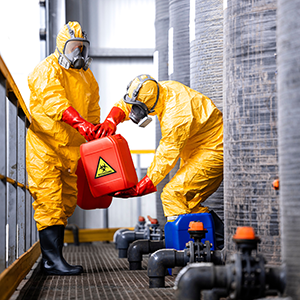Chemical Safety: What Updates to the Toxic Substance Control Act Means for Employers

Services:
Markets:
Chemical Safety: What Updates to the Toxic Substance Control Act Means for Employers
by Richie Stilwell, CSP | September 3, 2025
In today’s regulatory landscape, staying compliant with chemical safety laws is not just about meeting minimum standards, it’s about protecting your workforce, your operations, and your reputation. The 2016 Frank R. Lautenberg Chemical Safety for the 21st Century Act represents a major shift in how chemical risks are managed in the U.S., and workplaces across many industries need to understand its implications.
This landmark legislation significantly enhanced the Environmental Protection Agency’s (EPA) authority to regulate chemical substances through enforcement that pose risks to human health or the environment. The Toxic Substances Control Act (TSCA) now mandates risk-based evaluation of new and existing chemicals, requires EPA to act when unreasonable risk is identified, and aligns corrective actions with the expectation of Occupational Safety and Health Administration’s (OSHA) hierarchy of controls. Importantly, TSCA now recognizes workers as part of the “susceptible population”, which requires that a chemical’s potential impact to workers’ health be considered in each chemical risk assessment.
One of the major improvements is the creation of enforceable health standards. Previously, OSHA’s outdated permissible exposure limits (PELs), many based on 1960s data, left thousands of chemicals under-regulated. Now, through TSCA, EPA must take direct action to manage risks identified during the chemical risk assessment. Direct action could include banning a chemical or establishing chemical exposure limits for that chemical’s use in the workplace. The update also lays out clear expectations for a Workplace Chemical Protection Program (WCPP) for employers, which includes exposure monitoring, implementation of engineering and administrative controls, identification of regulated work areas, personal protective equipment (PPE), and worker training.
The law also introduces rigorous pre-market reviews for new chemicals and directs EPA to prioritize existing chemicals with high acute or chronic toxicity, high persistence and bioaccumulation score, or are identified as known human carcinogens. An important distinction made in the update is that EPA decisions must be based solely on health and environmental risks, without factoring in cost, and must be followed by timely regulation.
With more than 85,000 chemicals on the market the stakes for worker health are high. In fact, occupational diseases cause more deaths than workplace injuries, with costs exceeding $46 billion annually. These changes to TSCA represent a more proactive, science-based strategy to protect workers from chemical hazards. Whether you're unsure how these changes affect your operation, or you're working with a TSCA-regulated chemical and need help creating a WCPP, we’re here to guide you through the process with practical and cost-effective compliance solutions.
Services:
Markets:
